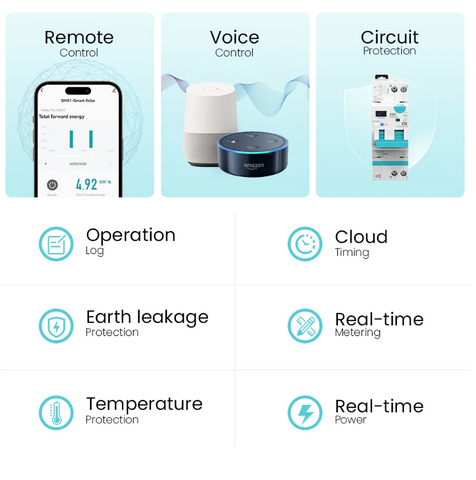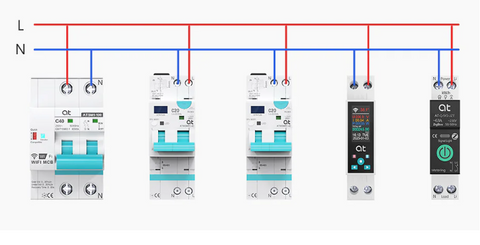The Most Efficient WiFi Circuit Breaker Technology
In our modern, technology-driven world, electricity is the lifeblood of our homes, businesses, and industries. However, with the increasing reliance on electrical power, the importance of electrical safety cannot be overstated. Ensuring the secure and efficient flow of electricity is crucial for preventing accidents, fires, and damage to electronic devices.
Circuit breakers stop electricity when there's a problem, protecting electrical systems from damage or overload. Enter the era of WiFi circuit breaker technology. This innovative approach represents a paradigm shift in electrical safety, integrating cutting-edge features that go beyond the capabilities of traditional circuit breakers. In this blog, we'll explore how WiFi breakers are revolutionizing electrical safety.
I. Understanding WiFi Circuit Breaker Technology
A. Definition and Basic Principles of WiFi Circuit Breakers
WiFi circuit breakers leverage advanced technologies to provide a dynamic and responsive approach to electrical safety. They are made to do more than just turn on and off like regular breakers. They add smart features and connectivity to electrical protection.
B. Components and Features of WiFi Circuit Breakers
Learn how WiFi circuit breakers work, from anomaly-detecting sensors to real-time monitoring communication modules. These devices are equipped with features that enhance safety, efficiency, and control over electrical systems.
C. How WiFi Circuit Breakers Differ from Traditional Counterparts
Dive into the key differentiators between WiFi circuit breakers and their traditional counterparts. From remote control capabilities to predictive maintenance through data analytics, discover how these innovations are reshaping the landscape of electrical safety.
II. Key Innovations in WiFi Circuit Breaker Technology
The evolution of electrical safety has reached a transformative phase with the advent of WiFi circuit breaker technology. These innovations redefine our approach to managing electricity, offering a range of once-unimaginable features. Let's delve into the key innovations that make WiFi circuit breakers a game-changer.
A. Remote Monitoring and Control Capabilities
WiFi circuit breakers offer convenience and control with remote monitoring and control features. Imagine being able to control your electrical system from your smartphone, checking its status and turning off circuits remotely. This feature makes it easier to access and quickly respond to problems without being physically present.
B. Real-time Data Analytics for Predictive Maintenance
WiFi circuit breakers can use real-time data analytics to improve their performance. By continuously monitoring electrical parameters, these devices can identify patterns and trends that may indicate potential faults or wear. This proactive approach enables predictive maintenance, reducing downtime and the risk of unexpected failures. Businesses and homeowners alike can benefit from a more reliable and resilient electrical infrastructure.
C. Integration with Smart Home Automation Systems
In an era of interconnected homes, WiFi circuit breakers seamlessly integrate with smart home automation systems. This integration allows for a cohesive and streamlined approach to managing various aspects of home automation. WiFi breakers and home automation systems collaborate to enhance the efficiency and intelligence of homes. They achieve this by controlling lighting, and appliances, and monitoring energy consumption.
D. Enhanced Safety Features and Rapid Response Mechanisms
Safety is very important, and WiFi circuit breakers make it even better with improved safety features and quick response mechanisms. These devices can quickly detect issues such as short circuits or electrical overloads. They react promptly to minimize the risk of harm or accidents. Using advanced technologies ensures a quick and accurate response to possible dangers, making them important for keeping an electrical environment safe.
III. Advantages of WiFi Circuit Breakers
With these groundbreaking innovations, WiFi circuit breakers offer a multitude of advantages that extend beyond traditional electrical safety measures.
A. Improved Electrical System Reliability
The real-time monitoring and predictive maintenance capabilities of WiFi circuit breakers contribute to improved electrical system reliability. By addressing potential issues before they escalate, these devices enhance the overall stability of electrical networks, reducing the likelihood of outages and disruptions.
B. Enhanced Safety for Homeowners and Businesses
The combination of remote monitoring, rapid response mechanisms, and advanced safety features significantly enhances the safety of both residential and commercial spaces. Homeowners and businesses can enjoy peace of mind knowing that their electrical systems are not only secure but also equipped to respond swiftly to any potential risks.
C. Energy Efficiency and Cost Savings
WiFi circuit breakers contribute to energy efficiency by optimizing the use of electrical resources. The ability to monitor energy consumption in real-time allows for informed decisions on energy usage, leading to potential cost savings over time. This feature aligns with the growing emphasis on sustainability and responsible energy management.
D. Contribution to a Smarter and Interconnected Infrastructure
WiFi circuit breakers are crucial for building a more intelligent and connected infrastructure. They achieve this by collaborating with home automation systems and utilizing advanced technologies. This connection improves homes and businesses and helps create smart cities and sustainable urban development.
IV. Case Studies Successful Implementations of WiFi Circuit Breakers

WiFi circuit breakers are making a real impact in different industries and places all over the world. Let's explore some compelling case studies that showcase successful implementations and the real-world outcomes and benefits observed.
A. Examples of Industries or Locations Where WiFi Circuit Breakers Have Been Deployed
1. Commercial Buildings
WiFi circuit breakers have found a home in commercial buildings, where the demand for energy efficiency and safety is high. These installations often involve integration with building management systems for centralized control and monitoring.
2. Data Centers
The critical nature of data centers demands a robust electrical infrastructure. WiFi circuit breakers are implemented to ensure the continuous and reliable operation of these facilities. The ability to detect and address potential issues in real-time is crucial for preventing downtime and data loss.
3. Manufacturing Plants
In manufacturing plants, where heavy machinery and complex electrical systems are prevalent, WiFi circuit breakers provide an extra layer of protection. The predictive maintenance capabilities help optimize production processes by minimizing unexpected downtimes.
4. Residential Smart Homes
Homeowners are embracing WiFi circuit breakers as a fundamental component of smart home ecosystems. These devices are compatible with other smart devices. They allow people to monitor and control their electrical systems remotely. This provides convenience and enhances safety.
5. Renewable Energy Installations
The rise of renewable energy installations, such as solar and wind farms, requires sophisticated electrical infrastructure. WiFi circuit breakers help manage power from renewable sources, ensuring smooth integration with the grid.
B. Real-World Outcomes and Benefits Observed in These Implementations
1. Reduced Downtime
Across various industries, the implementation of WiFi circuit breakers has resulted in a significant reduction in downtime. Real-time monitoring and predictive maintenance enable proactive measures, preventing electrical failures before they can disrupt operations.
2. Enhanced Safety
The advanced safety features of WiFi circuit breakers have proven to be instrumental in preventing electrical accidents. Quick response systems and remote monitoring quickly address problems, reducing risks to people and things.
3. Improved Energy Efficiency
In commercial buildings and residential settings, the integration of WiFi circuit breakers has led to improved energy efficiency. Monitoring and controlling power consumption in real-time helps make smart choices that save electricity bills and protect the environment.
4. Optimized Maintenance Costs
Predictive maintenance facilitated by WiFi circuit breakers has not only minimized downtime but also optimized maintenance costs. By addressing issues before they escalate, organizations can plan and execute maintenance activities more efficiently, reducing overall maintenance expenses.
5. Seamless Integration with Smart Systems
The integration of WiFi circuit breakers with existing smart home or building automation systems has resulted in a seamless and user-friendly experience. This interconnectedness enhances the overall functionality and efficiency of the broader ecosystem.
V. The Future of Electrical Safety Trends and Predictions

A. Widespread Adoption of Smart Technologies
The integration of smart technologies, including WiFi circuit breakers and other connected devices, is expected to become more ubiquitous. Homes, businesses, and industries will increasingly leverage interconnected systems for enhanced safety, efficiency, and convenience.
B. Customization and Personalization of Electrical Systems
Future electrical systems will likely offer more customization options, allowing users to tailor their systems to specific needs. Customized safety and energy settings will improve electrical safety by focusing on the user's needs and preferences.
C. Increased Focus on Sustainability
As the world grapples with environmental challenges, electrical safety solutions will align with broader sustainability goals. This includes the integration of renewable energy sources, energy-efficient technologies, and smart systems designed to minimize environmental impact.
D. Collaboration between Industries and Technology Providers
The future of electrical safety will see increased collaboration between industries and technology providers. This collaboration will be crucial in establishing common standards, addressing interoperability challenges, and accelerating the adoption of innovative electrical safety solutions.
VI. Conclusion
As we envision the future of electrical safety, the key lies in embracing innovation. The trends we've explored, from WiFi circuit breaker solutions, pave the way for a safer and more sustainable future. People, companies, and industries need to actively adopt and invest in these technologies. This will create a time when electrical safety becomes not just important, but a responsibility that we all have.
Contact:
sale@at-ele.com




